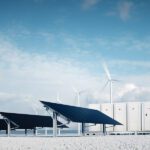The decentralization of electricity production and delivery is evident in the commercial and industrial (C&I) sector, as businesses move to produce their own power to ensure a reliable and resilient supply of energy.
Keeping the lights on 24/7 is a focus for commercial and industrial (C&I) enterprises, which have always sought reliable and resilient power supplies. It’s an even greater concern as severe weather becomes more common, and utilities and power producers battle the challenge of avoiding disruptions despite an aging power grid.
Data centers are a prime example. The energy-intensive nature of processes for artificial intelligence and advanced technology means such enterprises want control over their power supply, which is why so many tech companies are procuring power purchase agreements or looking to secure on-site generation resources.
As business operations become more complex, C&I groups are looking at varied and advanced technologies to provide energy. They may want precise control over voltage, and also to address safety concerns. Cost is always a factor, which means businesses are seeking the most efficient and cost-effective technologies to power their pursuits.
Backup power systems such as generators or battery energy storage are being incorporated into infrastructure. Companies also want energy management systems that can monitor and control energy consumption, and promote energy efficiency and cost savings along with reliability and resiliency.
“Utilities are leveraging several different technologies to help design C&I power systems,” said Gilbert Michaud, an assistant professor at Loyola University in Chicago, Illinois. “Smart grid technologies such as advanced metering infrastructure [AMI] are used to help observe and manage energy use in real time, and supervisory control and data acquisition [SCADA] is another tool used to manage power and grid operations.”
Michaud told POWER, “As the C&I sector continues to desire renewable energy solutions, solar PV [photovoltaic] design tools, energy storage, and microgrid controllers are also being deployed. Other technologies, such as advanced protective relays, are also helping utilities to design C&I power systems to meet industry needs in a reliable and efficient way.”
Brandon Young, CEO at Payless Power, a Texas retail energy provider, said, “The focus of many businesses is on reliability, cost savings, and sustainability, making commercial and industrial power systems a fast-changing landscape. More firms have embraced on-site power generation technologies, including solar panels, CHP [combined heat and power] systems, and backup generators. Other than enhancing resilience, these technologies enable businesses to hedge against increased utility costs and outages.
“Energy storage systems, especially lithium-ion batteries, are fast becoming one of the core components of C&I power solutions. Their key inclusion in rationale is because they store energy utilized at the time of peak demand or during an outage so that businesses can keep operating even if the grid goes down,” said Young. “In addition, many companies have coupled batteries with renewables, such as solar, resulting in a hybrid system that gives both reliability and sustainability.”
A Reliance on Resilience
There are several types of C&I power systems incorporating an array of equipment. Some buildings feature transformers that can “step down” voltage from the power grid to a suitable level for building distribution. Switchgear, or devices to control and protect electrical circuits, including circuit breakers and fuses, also can be utilized. Uninterruptible power supplies, or UPS, have been used for years to provide backup power to critical systems during power outages.
Michaud said on-site power production is key for many C&I enterprises, with several important considerations—such as finances, decarbonization, and more—needed when designing a system.
“This is increasingly important for the C&I sector. In addition to the obvious energy cost savings, energy resilience is a major driver of on-site production,” said Michaud. “For critical facilities such as hospitals, military sites, manufacturers, and others, uninterrupted operations are paramount, and on-site generation with microgrids or storage can help ensure power continuity during outages. While decarbonization and sustainability goals are important considerations, cost and reliability are the most strategic reasons for on-site power.”
Spencer Nervig, EnerVenue’s senior director of Product Management and Application Engineering, told POWER his company has “experience with C&I systems designed for resiliency, as well as solar-plus-storage systems that combine resiliency with energy cost optimization through reduced demand charges, peak shaving, energy arbitrage, or reduced fuel consumption. The modular design of our batteries allows for energy storage projects to be easily sized from C&I to grid-scale applications.”
Said Nervig: “Understanding a customer’s needs, site requirements, and goals for integrating C&I power systems is critical to designing, installing, and operating a successful project. Understanding a customer’s load and usage requirements allows a solutions provider to properly size a system with appropriate controls. Likewise, it is important to know, consult, and implement an O&M [operations and maintenance] plan that enables successful, and profitable, long-term operation.”
Michaud told POWER, “There are many, many examples of successful projects. Renewable energy integration and efficiency continue to be pillars of corporate sustainability missions, and are increasingly being driven by tech companies with data centers. For instance, the Turquoise Solar Project in Washoe County, Nevada, is a 61-MW solar farm being used to help power Apple’s data center in Nevada. Wind energy from the 298-MW Canadian Hills wind farm is being used to power Google data centers in Oklahoma. There are many other examples using large-scale batteries, solar thermal, and other advanced energy technologies.”
Building a Better Boiler
Ashwin Salvi, co-founder and chief commercial officer for Colorado-based AtmosZero, said his company “is focused on decarbonizing industrial steam by developing a cost-effective, plug-and-play solution at scale. Industrial steam has long been generated by burning fossil fuels, but as companies seek to improve their sustainability metrics, fossil fuel boilers need to be replaced with a cleaner solution.”
 |
|
1. An AtmosZero employee finalizes the construction of a Boiler 2.0 air-sourced heat exchanger, which can help decarbonize industrial heat. Courtesy: AtmosZero |
Salvi said AtmosZero developed “a drop-in, air-sourced, steam generating heat pump [Figure 1] that can provide up to 50% of industrial heat needs and offer customers operational cost savings compared to other decarbonized technologies. The system consists of electrically driven refrigerant compressors, inverters, and control systems. As industrial heat continues to be decarbonized, C&I power systems will continue to play an increasing role.”
Salvi said AtmosZero’s first installation is for New Belgium Brewing, a beverage company in Fort Collins, Colorado, with a system expected to begin operating within a few weeks. “This system will go live at the end of Q1 [first quarter] 2025,” said Salvi. “New Belgium is on a mission to decarbonize their manufacturing processes, using a full spectrum of technologies from renewable electricity to renewable natural gas and even carbon capture.
“An unsolved challenge for them was how to make decarbonized steam cost-effective. Steam production occurs primarily through water boilers powered by natural gas combustion. The incumbent method of steam production is low cost because of the boiler technology and fuel source, but it does generate on-site emissions,” said Salvi. “Until our Boiler 2.0 technology, the only alternative method of steam generation was through electric-resistive boilers. While these systems have low capital expenses, they have high operational costs due to low efficiencies and high electricity consumption. Using the AtmosZero steam generating heat pump enables customers like New Belgium to achieve the sustainability goals in a low-cost and scalable approach.”
 |
|
2. Vicinity Energy has launched eSteam, a carbon-free thermal energy product. Courtesy: Vicinity Energy |
Massachusetts-based Vicinity Energy, a U.S. leader in district energy systems, recently announced the launch of eSteam, a carbon-free thermal energy solution. The company unveiled its inaugural 42-MW industrial-scale electric boiler (Figure 2) at its facility in Cambridge, Massachusetts. Vicinity said its eSteam system is “a pivotal advancement in urban sustainability. Boston- and Cambridge-based customers have partnered with Vicinity to use eSteam in their buildings as an immediate solution for reducing carbon emissions.”
Vicinity imports renewable electricity through its co-located substations to power the electric boiler, generating carbon-free eSteam. Leveraging its established underground steam network, Vicinity delivers eSteam directly to customers.
“This milestone is about more than just technology—it’s about turning the vision of a cleaner, more sustainable future into reality for our customers and cities,” said Kevin Hagerty, president and CEO of Vicinity Energy. “The strong interest from our customers underscores that the transition to carbon-free thermal energy is both urgent and achievable today. With eSteam, Vicinity is leading the way in redefining sustainable urban energy solutions.”
Vicinity is contracted to supply eSteam to organizations such as Emerson College, whose main campus is in Boston, and IQHQ, a life sciences company with a campus at Alewife Park in Cambridge.
“The launch of eSteam marks a major step forward in our journey toward cleaner energy,” said Jennifer Lamy, associate director of sustainability at Emerson College. Lamy said the technology is now heating campus buildings, “and in the next several years, all of Emerson’s steam-heated buildings will be heated with carbon-free eSteam. Our use of eSteam will contribute significantly towards our goal of carbon neutrality by 2030.”
Driving Down Emissions and Costs
Doron Shmueli is CEO of MayMaan, a company whose AquaStroke technology (Figure 3) is enabling internal combustion engines to run on cleaner, water-based fuel, reducing both costs and emissions. Shmueli told POWER his company’s “core technology focuses on clean energy generation using carbon-neutral renewable fuels, achieved through the elimination of NOx emissions via high-moisture internal combustion engines. These engines utilize biofuels and renewable synthetic fuels. Combustion with high-moisture-content fuels reduces peak temperatures, effectively eliminating NOx formation while enhancing fuel efficiency. This integrated approach delivers a cleaner, more sustainable energy generation system, reducing both carbon emissions and harmful pollutants, thereby supporting the transition to a low-carbon energy future.”
 |
|
3. MayMaan’s AquaStroke technology is enabling internal combustion engines to run on cleaner, water-based fuel, reducing both costs and emissions. Courtesy: MayMaan |
Eitan Shmueli, the company’s president, said MayMaan has “seen strong success with our commercial deployments of 35-kW renewable fuel generators. These systems integrate seamlessly into existing infrastructure to provide reliable, low-emissions power. They have proven particularly effective in underserved markets, where their smaller kilowatt capacity and attractive total cost of ownership offer an ideal solution for businesses aiming to control costs while meeting performance and sustainability benchmarks.” Eitan Shmueli said MayMaan is “expanding our efforts to scale these solutions to a 1-MW capacity. This initiative aims to serve larger commercial and industrial loads while adhering to the same principles of cost-effectiveness and decarbonization. By combining our proven approach with advanced engineering, we are addressing the growing demand for more robust, sustainable power systems that support financial viability alongside ambitious emissions-reduction goals.”
Karina Hershberg, an associate principal at PAE Engineers, said her company’s “onsite energy projects have mostly focused on PV with BESS [battery energy storage system]-based system architectures. When configured as microgrids, some of our projects have also included a generator as an additional level of support. The generation is often best used as a backup to the backup and only engaged if the other systems have depleted their capacity.”
Hershberg told POWER, “We have a community project in California in early design considering small-scale biomass for both electric and thermal energy. The design concept is to use the biomass for baseload generation with PV and battery layering on as both a grid-connected resource and an off-grid resilience system. The project is located in a region with a historic timber economy and an increased wildfire risk so the added benefit of the biomass system is the potential for an energy system that also creates economic revitalization and beneficial forest management.”
 |
|
4. PAE Engineers designed the PAE Living Building in Portland, Oregon. It’s a commercial building in a downtown area with a 125-kVA/256-kWh onsite battery, and 133-kW rooftop solar array in a microgrid configuration. Courtesy: PAE Engineers |
Hershberg highlighted the PAE Living Building (Figure 4), located in downtown Portland, Oregon, as a model project. “This project is a commercial building in an urban core with a 125-kVA/256-kWh onsite battery and 133-kW rooftop PV array in a microgrid configuration [which can operate grid-connected and grid-disconnected],” said Hershberg. “This project is especially unique because the local grid network has a limit on the allowed back-feed from the building system onto the utility network, which greatly limits the net-metering output from the PV system. To account for this limitation, the microgrid system uses as much of the PV generation onsite by storing excess in the battery, discharging the battery to support building loads when the PV is offline, and then recharging the next day with the excess PV. Since it’s also a microgrid, in an outage, building loads can continue to operate with the onsite resource.”
Supporting On-Site Power Systems
Michaud said electric utilities and local governments should provide incentives for C&I enterprises to incorporate on-site power systems, noting their importance for both today and the future.
“Many already are [offering incentives] through tax credits, grants, rebates, and other programs. Not only does this offer benefits to C&I enterprises themselves, but there are broader community benefits such as improved air quality and health, economic and workforce development, energy security, and emergency preparedness,” said Michaud. “On-site power systems reduce the strain on the grid and help utilities reduce expensive infrastructural upgrades, as well as help with local load balancing. Decentralization and independence are key to a resilient energy future.”
Said Eitan Shmueli: “Providing incentives for on-site power systems is both prudent and strategic for utilities, local governments, and businesses. The net power curve—which illustrates how on-site generation alters the timing and magnitude of energy drawn from the grid—is a critical factor in determining the value proposition of these systems. By smoothing out peaks and reducing reliance on the grid during high-demand hours, on-site power resources mitigate the ‘duck curve’ effect, where net load dips at midday and spikes in the evening. This contributes to grid stability, lowers demand charges, and creates opportunities to optimize energy usage and storage.”
Nervig agreed on the need for incentives. “State and local government support for C&I customers is a key element in expanding the use of on-site power systems. As an example, federal, state, and local incentives have helped grow the grid-scale and residential solar energy sector, including storage, but C&I incentives have lagged, creating the need for additional incentives to help the market mature,” said Nervig. “Added incentives provide technology and service providers the long-term stability needed to foster a healthy, thriving market. Done correctly, incentives beget investment, which drives costs lower for all market participants in the long term.”
—Darrell Proctor is a senior editor for POWER.











